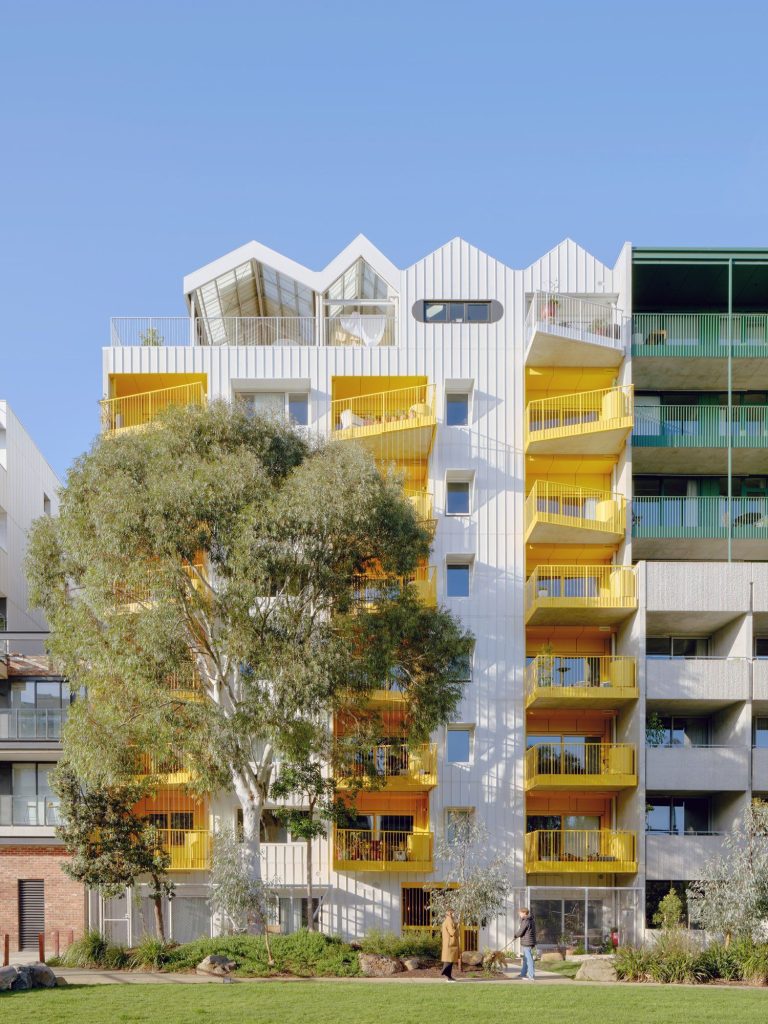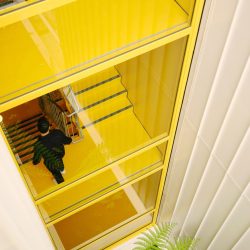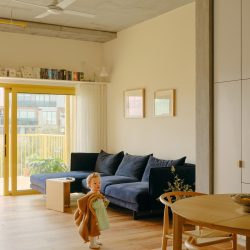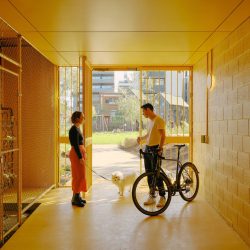
Austin Maynard Architects . photos: © Tom Ross
With a whopping energy rating of 9.1 stars, ParkLife is Austin Maynard Architects’ evolution of, and follow up to, its multi award winning sustainable community Terrace House. Again as both architect and developer, Austin Maynard Architects has taken all the hard earned lessons from Terrace House and improves upon them in the all-electric, fossil fuel free, super-sustainable ParkLife apartments.
THE WHAT
Located in Brunswick and set within the Nightingale Village – Australia’s first carbon neutral residential precinct – ParkLife is a high-performing, beautifully designed, community-focused apartment building containing 37 homes and two commercial tenancies.
Regarded as the social hub of the village, ParkLife has a distinctive mountainous roofline and a unique rooftop amphitheatre, as well as a variety of social/communal areas, diverse in scale, location and character. Homes within comprise of 14 one-bedroom, 19 two-bedroom, 2 three-bedroom and 2 Teilhaus apartments, each designed to extol space-efficiency, functionality and flexibility. Five of the apartments are designated social housing, through Housing Choices Australia.
Excelling within the industry code for sustainability, ParkLife has an average NatHERS rating of 9.1 stars, making it the most sustainable building at The Village.
IT TAKES A VILLAGE
The precinct is a project of international significance. Six buildings, each designed by a local award-winning architecture firm, with social, environmental, ethical and sustainability principles at the core. Facing out to Bulleke-Bek Park, Austin Maynard Architect’s ParkLife makes up half of the northside of The Village, with Claire Cousins Architect’s Evergreen to the west. Designing our buildings concurrently allowed for a wonderful opportunity to collaborate as neighbours to create a number of special outcomes, including reciprocating light wells. By adjoining our light wells we were able to the double the space, which allowed for double the garden at ground level and double the amount of natural light streaming in through the core.
Throughout the precinct, communication with all the architects of the village, was a constant. With shared enthusiasm and intent this co-ordinated approach led to a consistent grouping of individual buildings, all conversing but each with different personalities and a divergent set of homes within.
THE PERFECT EVOLUTION
After the success of our first multi-residential development, the internationally recognised, award winning Terrace House, the question was, what next?
The answer was ParkLife. Taking on the mantle of both developer and architect once again, ParkLife is the perfect evolution and natural progression. Informed by lessons learned from Terrace House we were able to refine, perfect and improve upon, to differentiate between what was aspirational and what was truly effective. Notable amongst the refined lessons was the reuse of Energy Recovery Ventilation, with each home continually provided fresh air through heat exchangers that resulted in minimal temperature loss. This again allowed us to produce a building with no active heating or cooling. Also, thermal bridging was radically reduced by enveloping the majority of concrete in insulated panel. Hand in hand with this we also carefully purged elements used at Terrace House that were worth exploring but didn’t meet our own high targets, such as the balustrading and the membrane balconies. Where Terrace House achieved a “outstanding” and ‘world leading’ 8.1 star classification, ParkLife has attained an inspired 9.1 star energy rating. The highest rated building in The Village.
NO PROBLEMS, ONLY OPPORTUNITY
At Austin Maynard Architects we endeavour to put a positive spin on the inevitable issues that arise in design and development. Turning difficulties into opportunities and negatives into joyful returns.
Our site was challenging, with pre-existing interface to the east (a residential block with inset apartments) and proposed planning for an apartment building of a similar scale at the rear. Fortunately, just prior to construction, the council acquired the rear site and approved a public park instead. The opportunity allowed us to create private garden areas for the homes at ground floor level, merging into the park. As architects we have always sought to make a beautiful connection between public and private. Instead of building walls, we connect. Now afforded a lush outlook we were able to share the opportunity with The Village. By separating our ParkLife community entry and secure bike parking we made a pathway, creating a central walkway right through the centre of our building, to connect The Village ‘hub’ at Duckett Street with the new park. Without this direct access, residents of The Village would have to walk around the precinct and navigate a very busy bike and pedestrian footpath, or else traverse an uninviting laneway on the other side.
As well as responding to site, it was important to look at the precinct as a whole. We worked within the guideline envelope provided, including height limits. Through negotiation, council required our building to drop down in the south east corner, where it neighboured the pre-existing apartment block. This led to the opportunity to create an incredible two-story apartment with an expansive private terrace, and also a very special communal area. The amphitheatre is a unique residential space for the community of ParkLife. A landscape element that cascades down with views into Duckett Street and right across the city.
MATERIALITY
The exterior of ParkLife is highly insulated white steel cladding, with cables, grills and rods to allow vegetation to proliferate. To reduce carbon and increase insulation performance we avoided using external pre-cast concrete panel cladding, typically used in apartment buildings. The white Askin panel cladding is a colorbond panel, which has a high-performance, fire-proof insulated core. The white colorbond finish exterior has a high reflectance, radically reducing heat gain in summer and further reducing heat island effect in the area. The cladding’s strong vertical lines softens the building to a residential scale, in opposition to a pre-cast concrete panel used in most apartment buildings.
“IT STANDS FOR THE SUN”
ParkLife deliberately encapsulates and celebrates some of the most striking elements of Austin Maynard Architects’ residential back catalogue. In referencing our work to be a recognisable Austin Maynard Architects project, we borrowed various visual aspects such as the mountainous roof line from RaeRae House, the white steel balustrade from Greenacres and the colour yellow, as celebrated in My-House, Alfred House and Mills House. While on the central precinct side (Duckett Street) the external materiality is a crisp white steel, where ParkLife looks out across the park the exterior is highlighted by a bright sunny yellow.
The colour extends a visual consistency throughout the building, including all common area thoroughfares, bike store and large planter boxes, as wells as the articulate balconies on the Northern side. As a way of avoiding unnecessary expense (and in turn increasing the cost of each home), services within the common areas remain exposed. To avoid a messy environment full of different pipes and conduits we decided to paint everything in the same yellow, so the eye sees the space not the smaller details.
The glazed staircase is also bright yellow and, rather than a standard dimly-lit concrete tunnel, is flooded with natural light, with views and greenery, while showcasing the life within the building.
To quote Vince Van Gogh: “How lovely yellow is. It stands for the sun.”
PERSONAL SPACE
The interior palette of materials were kept deliberately simple; timber floors, white walls, white cabinetry, concrete ceiling and a terrazzo tile in the bathroom. The intent was to allow the community to personalise their homes rather than apply too many finishes and textures. Attractive, functional spaces were created with great views and lots of light, which can be embellished in any way the residents want to make the apartment their home.
MOMENTS OF JOY
Energy efficiency dictates how much glass you use in relation to solid wall. The area of glazing and orientation directly effects the energy rating. To create the most thermally efficient homes possibly we looked at the size and spacing of glass. The heads of the sliding doors out to the balcony were lowered to 2.1m and a shelf was installed to the interior to take advantage of that section of wall. The residents have really embraced them, with books and pots and plants cascading down.
In the one-bedroom apartments the joinery has been lowered to 2.1m and hangs off the ceiling as a long, wide open shelf. It can be used as extra storage or display space and curtains can be hung from the underside to give extra privacy.
These little moments that are logical, pragmatic and simple have become Austin Maynard Architects’ favourite parts of the building. Beautifully functional additions, rather than decorative. In the Austin Maynard way, functionality does not mean boring; moments of surprise and delight, simple and efficient, cost effective, strategic and playful. Moments of joy.
ALAN
There are three trees on the northern side of ParkLife, including one very large and established gum tree called Alan (named after the local man who planted them). Though the trees now have a grassy outlook, they were originally sewn into dirt along a disused rear laneway at the rear of a group of sheds and warehouses. The trees grew in a difficult environment with little attention. When the village sites were allocated we discovered Alan bordered our block. Saving Alan became of upmost importance. Bucking urban development norms of utilising every inch of the envelope to ensure maximum financial returns, we instead pushed our building 2 metres back off our boundary. Doing so, we protected Alan’s roots, allowed for further growth and provided space for the canopy to sit comfortably against the building and into the balconies. This was not only a victory for Alan and the Bulleke-Bek Park users, but also the ParkLife community, who love having their homes within Alan’s canopy. Many of ParkLife’s younger residents tell their friends that they live in a treehouse, rather than an apartment.
UP ON THE ROOF
In contrast to the big urban moments there is a domestic scale playfulness on the skyline. Instead of a large open, windswept terrace, ParkLife provides a series of spaces varying in size, function and character. Designed in collaboration with the Landscape Architects Openwork, spaces include a productive garden with fruit trees and a real grass lawn for picnics. There is a covered deck, big enough for large gatherings, with an electric barbecue, sheltered from the harsh sun and strong winds. There are practical facilities, a toilet, laundry and drying area. And then there’s the amphitheatre, perfect for social moments and special events, or watching the sunrise with your morning coffee.
SUSTAINABILITY
All decisions made in the design process were based on increasing the sustainability of the building. ParkLife is built very differently to the other buildings within The village and within the local area. The other apartment buildings have a high concrete content, which is cost effect and resilient but high in carbon footprint as well as problematic in terms of thermal bridging.
We used an insulated panel cladding instead of pre-cast concrete panels, with colorbond each side and an insulated core: Essentially the same approach as an esky. The whole building is sheathed in this Askin panel increasing the thermal performance of the external walls resulting in a very high energy rating. Attention was paid to ensuring all junctions were very well sealed – particularly around doors and windows – so that the interior temperature could be maintained and the cool or warm air was not lost through a leaky building. With a well sealed building moisture build-up can be an issue. To combat excessive moisture and to maintain a constant internal temperature in conjunction with building sealing an ERV (energy recovery ventilation) system is installed within each apartment. The unit sits above the bathroom ceiling with a duct to each room that takes the stale internal air exchanges it with the fresh air from outside at the same time transferring the heat and moisture to maintain a constant temperature inside the apartment.
Misters are installed within the light wells that mist out harvested water during the hotter days so that windows from the bedrooms can be opened up to draw in the cool air through cross ventilation.
There is no mechanical heating or cooling within ParkLife. All conditioning is carried out through passive methods and the ERV to maintain a comfortable internal temperature.
_
Traditional land owners
Wurundjeri Woi Wurrung
Austin Maynard Architects, project team
Andrew Maynard, Mark Austin, Mark Stranan
Site Area
706 m2
Total floor area
4210 m2 GBA
Completion date
May 2022
Developer
Austin Maynard Architects
Builder
Hacer Group
Project Managers
Fontic
Engineers
Structural & Civil – Irwin Consult
Mechanical Engineer – Irwin Consult
Electrical Engineer – Irwin Consult
Hydraulic Engineer – Irwin Consult
Fire Services Engineer – Irwin Consult
Fire Safety Engineer – Irwin Consult
Acoustic Engineer – Arup
ESD
Irwin Consult
Traffic Consultant
GTA Consultants
Planning consultant
Hansen
Access Consultant
Access Studio
Landscape Architects
Openwork
Waste Consultant
Leigh Design
Photography
Tom Ross






































